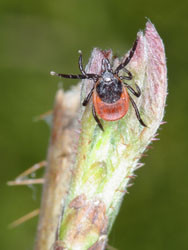Unravelling the transcriptome of the Lyme disease tick
The abundance of I. ricinus tick in Europe and its infection with Borrelia burgdorferi leads to increased risk of human exposure to Borrelia infection. The EU-funded RICYSTVACANT2010 project aimed at studying the components of tick saliva participating in bacterial transmission. Prior to this effort, scientists had very limited knowledge of I. ricinus genes expressed in the pathogen transmission interface of tick salivary glands. The project used a high-throughput approach to identify the expressed transcripts. RICYSTVACANT2010 deposited more than 27 500 transcript sequences in the GenBank as originating from the tick I. ricinus, providing extensive information on its gene expression regulation. It described the transcription patterns of 27 500 genes specific to the tissue and developmental stage, as well as a function of tick feeding time. The constructed transcriptome database allowed identification of approximately 1 500 tick proteins found in the pathogen transmission interface using proteomics. In addition to the transcriptome and proteome databases, library screens identified I. ricinus-secreted cystatins. Tick cystatins may work as 'silent' antigens for the development of anti-tick vaccines. The scientists cloned 15 cystatin genes and estimated their tissue specificity using real-time quantitative polymerase chain reaction as a function of tick feeding time. Four recombinant cystatins were successfully overexpressed in a prokaryotic system, characterised for their inhibitory effect on cysteine proteases and tested for their role in human immunomodulation. Pharmacological characterisation of the recombinant cystatins suggested their immunomodulatory function. One of the I. ricinus cystatins was able to ameliorate the symptoms of experimental asthma in mice. All the produced data are publicly available to support additional research projects targeting the specific tick and its pathogen transmission life cycle.







